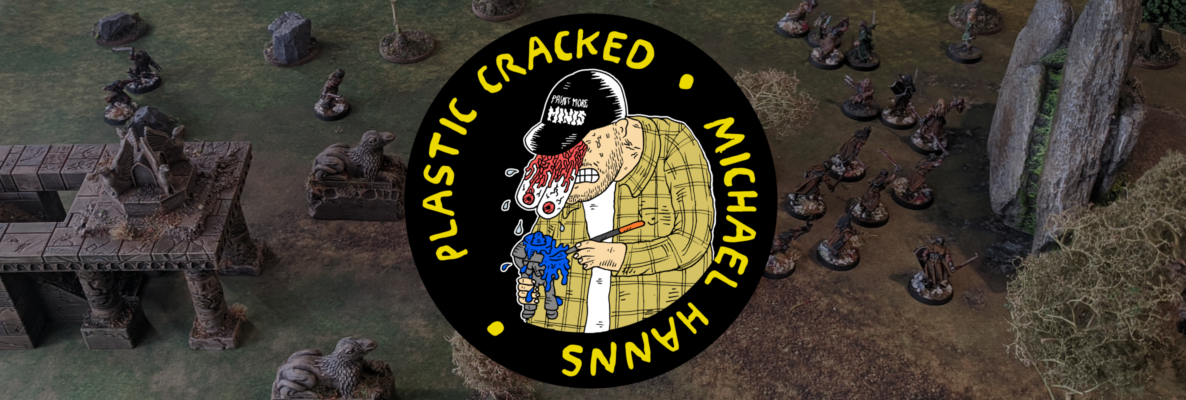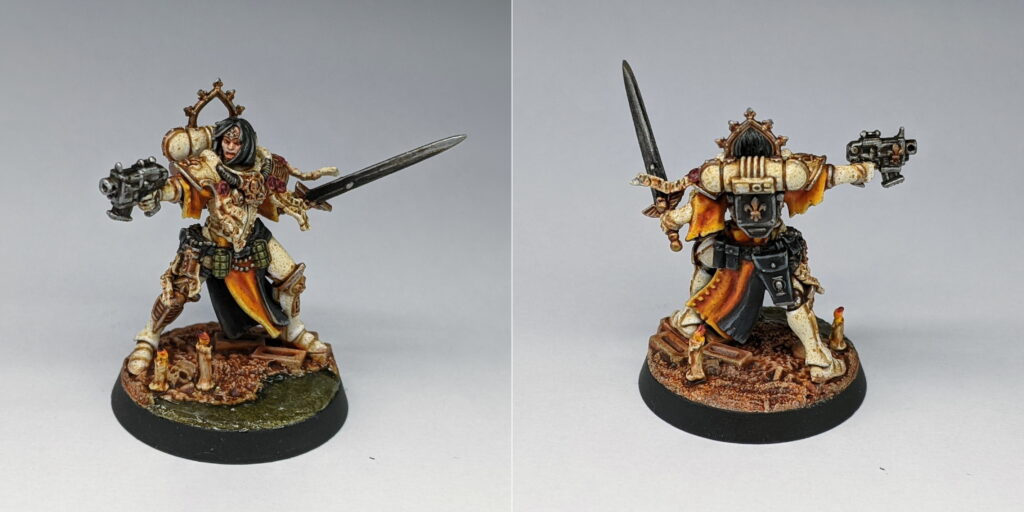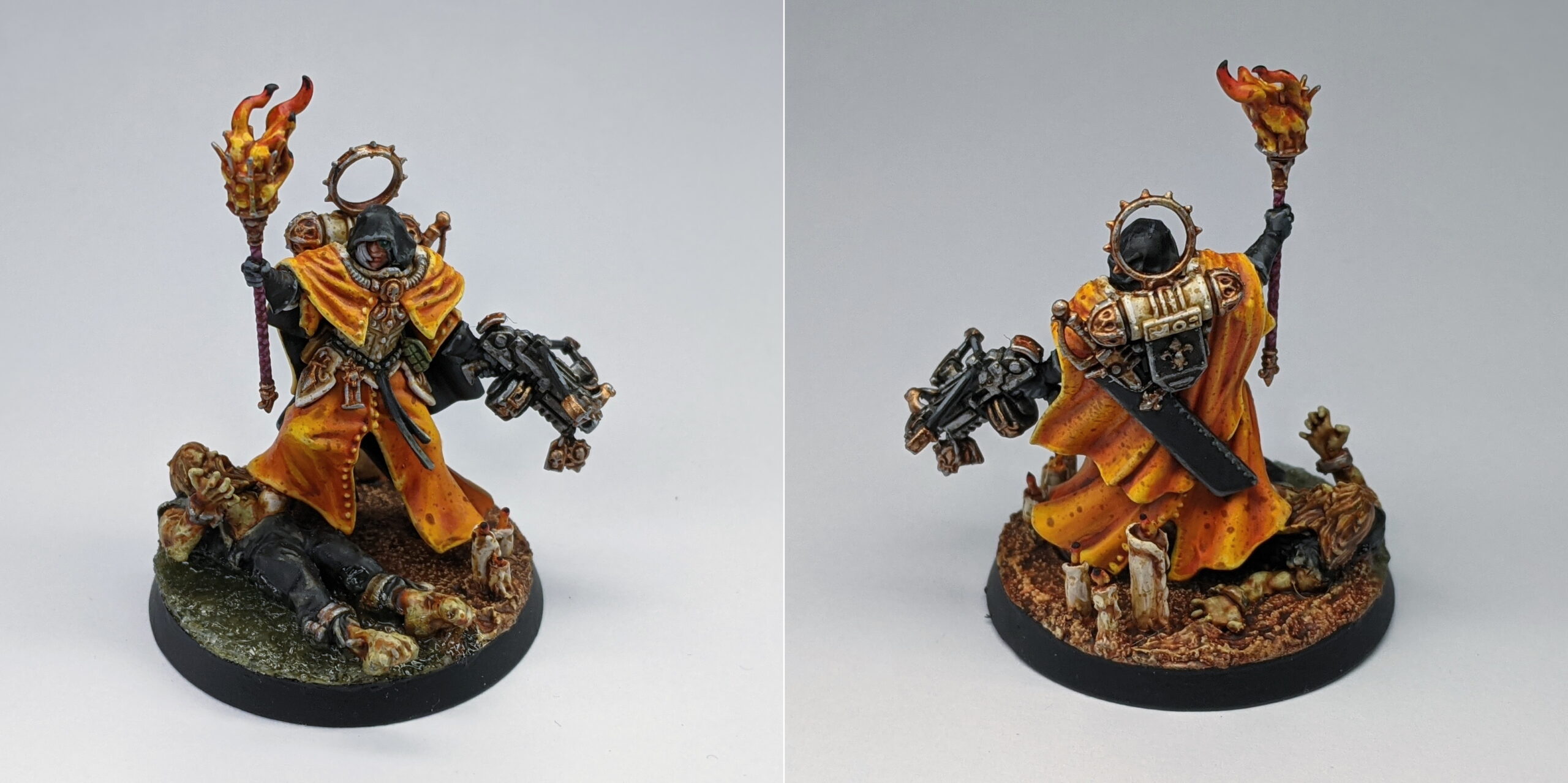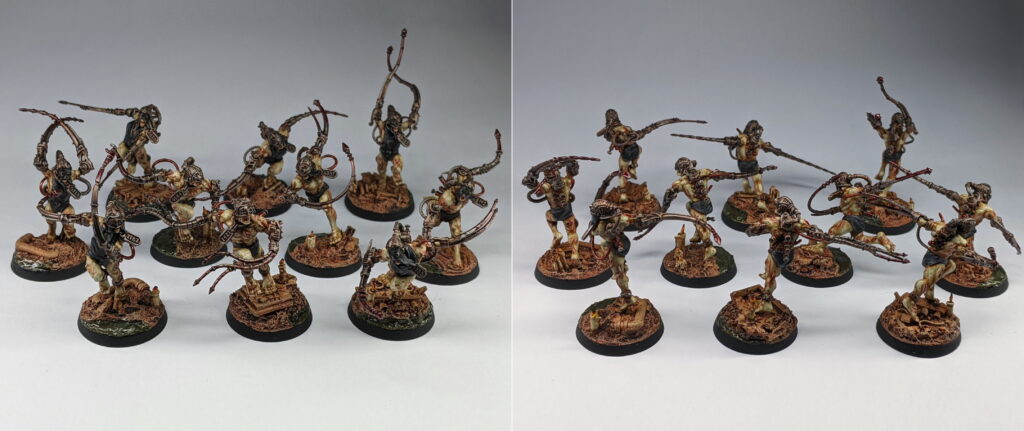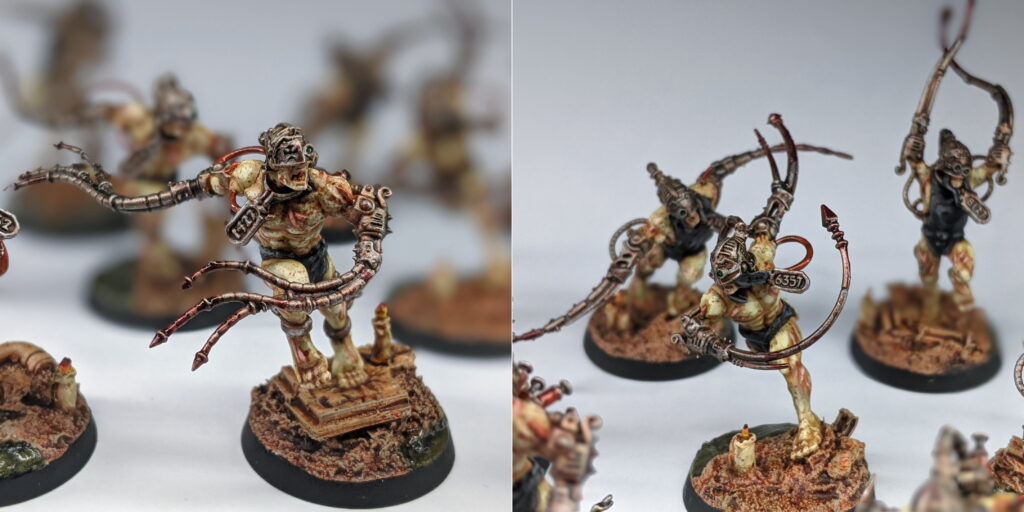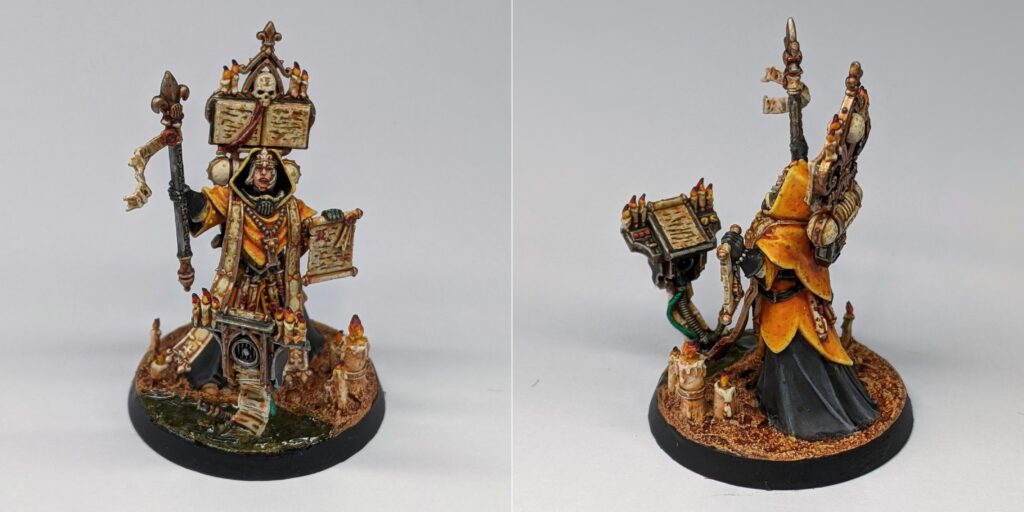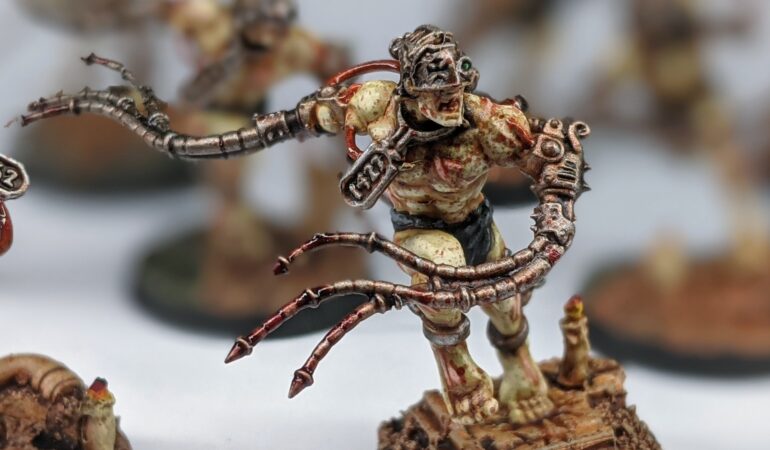
The single most intoxicating element to ‘finishing’ a big project is the freedom to pursue something fresh and new. I – like many (if not most) others in the hobby – have a backlog of sorts1, but the reality is that priorities can and will change over time. I was so sure I’d never tire of painting pigs for Malifaux while I was glazing the musculature on my Swine Cursed, then while waiting for Wave 2 of the minis to arrive, I occupied myself by making a long overdue start on my Sororitas. By the time the next batch of pigs arrived, I was already knee deep in Sisters of Battle with no hope of changing gears for the foreseeable. While I’m generally fairly fluid when it comes to building, as soon as I start putting paint on a new project, I tend to see it through until I reach a natural conclusion – even as painting functionally the same miniature over and over for three straight months inevitably starts to wear on me. Sure, it’s important to chase your muse – but in my experience, it takes a great deal more discipline to return to a project than to keep going with what’s in front of you. There’s a very real chance you’ll never return to a project once you stray, and it’s always better to leave something functionally complete that you can display or game with than a handful of out of place units and works-in-progress. A lot can happen in the time between painting that first test miniature and your ‘final’ Heavy Support choice. Hype levels rise and fall and minis you thought you couldn’t live without start to lose their lustre2 a bit. It can be liberating to do the responsible thing and work through your backlog, but more often than not – freed from the chains of a long-term project – I just want to experience that rush of something fresh and entirely out of left field.
So, you can imagine the internal conflict that arose within me when, just as I had resigned myself to move on from Adepta Sororitas for the time being, new miniatures were announced for the range. Here I was, finally finished painting a sea of white and orange, yet all I wanted to do was paint more Sisters.
With all the hype surrounding the new releases, the top of my todo list was – of course – the new Palatine from Piety and Pain. Not the most exciting character of all time, but a very utilitarian one – it’s always handy to have access to cheap HQ options, and I’ve never liked the idea of fielding two Canoness’ in a single list. I managed to pick one of these up on eBay and – seeing the sprue in hand – I couldn’t help but feel a little… uninspired. It’s not a bad miniature – I liked the head, backpack and the pose, but something about it seemed a bit plain. Fair enough she’s only a Lieutenant equivalent, but she seemed somehow less resplendent than some of my humble Battle Sister Superiors. This wouldn’t do.
Immediately, my thoughts turned to Tariana Palos – a limited edition Commemorative Series miniature based on a very cool and iconic piece of Sororitas art. Unfortunately for me, I did not pick one of these up at release – at the time, I was buried beneath a pile of yet unopened boxes of Sisters and more than a little ticked off by the tone deaf use of the phrase Know No FOMO for the announcement article. Eventually, I was able to track one of these miniatures down on eBay, albeit for a bit of a premium.
Although the conversion cost a bit more than I’d have liked, I do believe it was worth it for the resulting miniature. Tariana Palos is an awesome sculpt, her dynamic yet stoic pose, ornate power armour and prominent Rosarius making her every millimetre the Palatine I’d hoped for. Subtle details like filigreed trim and finery on her power armour help mark her out as an independent character – but not so ostentatious that you might confuse her for a Canoness. Still, she needed a little more to mark her out as a Palatine, so I had to make a few tweaks – starting with her wargear. I swapped her boltgun out for a bolt pistol and snipped off the visible grip in the holster at her waist (as this is the weapon she had drawn). I had hoped to attach the Palatine’s ornate looking sheathed power sword at her waist, there was too much else going on in this area – grenades, rosarius, holster, etc – it would have looked much too cluttered. Instead, I carefully snipped off Tariana’s open hand, replacing it with a closed fist brandishing a power sword from the Zephyrim kit. As a final touch, I replaced her head and backpack for those from the Palatine kit; the additional finery was welcome, but mostly I find that utilising as much of the original miniature as possible helps to make it clear what the conversion represents.
With a brand new Palatine in the bag, I thought it might be time for a new Canoness. While I love my Canoness Veridyan miniature for what it is, I can’t deny that it sticks out like a sore thumb in the army due to it’s obviously smaller scale. I’m not the biggest stickler for scale issues like these – my Repentia Superior is a little smaller, for example – but it feels wrong to use the smallest miniature in your collection to represent the most senior officer. Time to build a new one.
The first thing you’ll probably notice is that I replaced the rock under her foot with a begging penitent. As with my Imagifier before, I put together an unused Penitent Engine pilot, snipped all the wires and cabling from behind the model and removed the arm/waist restraints. Then I swapped out the pilots head with the sorriest looking head I could find in a box of Empire Flagellants, repositioning the neck and arms in a way that suggested he was begging for either forgiveness or mercy. A little careful positioning later and he became the new tactical rock for my Canoness (who is either immolating him, or ignoring him altogether depending on your perspective).
Aside from the base (for which I had to use a 40mm instead of the 32mm provided), the Canoness otherwise went together pretty much straight out of the box, although I did swap the decoration the power plant decoration for an iron halo from the other pack. For weapon choice, I just couldn’t see past the Brazier of Eternal Flame and Condemner Boltgun for that pure, Witch Hunter aesthetic.
As with my Palatine, this miniature was good fun to paint. After painting time consuming squads for so long, it’s gratifying to be able to take a complete project from sprue to Instagram in just a couple of evenings. Of course, after painting the grubby penitent under Lucerna’s heel, I was reminded of one element of the new Sisters range that I had been ignoring up until now – Arco Flagellants.
As you can probably imagine, I love these miniatures. They strike a magnificent balance – beautifully detailled without coming across as overly busy. They successfully modernise the old metal miniatures while paying homage to the incredible 54mm Inquisitor mini Damien 1427. They’re also surprisingly quick and easy to paint, which was a welcome break from the wearisome task of painting orange and ivory.
For my scheme, the skin is pretty much the same basic steps as my Squeaky Blinders or Azog’s Legion minis – a Dead Flesh basecoat, washed with Fuegan Orange and layered with a Dead Flesh/Elfic Flesh mix, finished with a watered down wash of Seraphim Sepia to bring it all together. I then picked out the scar tissue by applying a very thin layer of Bloodletter Red Glaze over the raised areas then highlighting the uppermost edge with a 50:50 mix of Rosy Flesh/Elfic Flesh. For the metals, I started from a base coat of Vallejo Metal Color Silver, washed with Fuegan Orange followed by Agrax Earthshade before somewhat carefully picking out some of the exposed edges in a controlled and deliberate drybrush-lite technique. After the miniature was varnished, I gave any exposed vials or smooth cabling – at this point painted in the same manner as the rest of the metallics – a coat of Spiritstone Red. The final touch was to flick a little Blood for the Blood God arterial spray across their chests with a toothbrush and brush a little on the tips of their weapons. Nothing to it, and I think they turned out pretty nice – they even appeared on the Hobby Roundup on Warhammer TV, which was cool.
Alongside my Arco-Flagellants, I had planned to run an Inquisitor – the idea here was that an Ordo Malleus Inquisitor could cast Power Through Knowledge on the Arco-Flagellants to give them a 5+ invulnerable save; this (when combined with their 5+ ignore wounds) would give them a reasonable chance at surviving on foot for long enough to see the combat phase. The boring thing to do here would be to buy one of the many excellent Inquisitor sculpts from Games Workshop or ForgeWorld – but this was too cool of an opportunity to convert something really fun instead.
Now, I had originally planned on writing about it here, but – as these things have a way of doing – that whole project has kind of exploded in scope. I don’t really have the time or space to get into it now, but I’ll be covering it in a brand new series of posts soon.
In the meantime however, how about a Dialogus?
I hadn’t planned to paint this miniature at all, truth be told – not any time soon, at least. I only came to possess one in the first place – having been entirely uninspired by both the rules and promo photos of the mini – because I was a little shy of qualifying for free postage on an Element Games order and figured I’d probably want one of these minis eventually. It would have remained in its box on my shelf for longer still, but for one night when I was watching TV with my fiancé and wanted something to build (having already ran out of any more pressing minis to build). I only primed it because I was priming other minis anyway and this miniature was nearby. I only started painting it because I was waiting for washes to dry on my Palatine and Canoness and I already had the necessary colours on my wet palette anyway. Thanks to this string of fortunate coincidences, by the time I finished my Arco-Flagellants, she was base coated, washed and just kinda seemed like an easy win.
Despite my initial misgivings, I actually really enjoyed painting this miniature. Seeing it painted in front of me, I’m now convinced that it’s a really cool sculpt – it just doesn’t translate well to a photograph. I don’t think it’s super clear from a front on shot what the servo-podium is supposed to be or how much presence it has, but it’s a really neat little feature. I like how laden this character is with ceremonial robes and – unlike the upcoming Dogmata miniature – manages to pull it off without looking like an amorphous blob of triangles. There’s a lot of different layers to the robes, and it makes for a fun opportunity to play around with the proportions of the colours in your scheme. There is also a lot of parchment, which will be a nightmare for some, but I quite enjoy painting the squiggly lines – although I am admittedly largely unambitious with it. Overall, it’s a nice little mini and it’s not nearly as busy in person as it looks in photos – actually striking a nice balance between densely sculpted detail and smooth volumes. If I had to level one criticism however, it’s that I’m not so sure it was a great idea to combine an open, shouting mouth with a coif covering most of her head – it’s really easy to unintentionally make her look pudgy, which comes off a bit comical. This is but a minor quibble however in the face of how far the Dialogus has come from her original, metal sculpt3.
Last but not least, we have my Seraphim Squad; I just couldn’t bring myself to move on to the next big project without first getting some paint on this iconic unit. Besides being the only Fast Attack unit in my army4 and an icon of the Adepta Sororitas predating even the Exorcist, I already had these miniatures assembled, primed, attached to paper clips for painting and stuck in a bit of foam next to my desk. I knew that if I left this stone unturned, they would be haunting my peripheries for months – I absolutely could not have that hanging over me, so out came the Fiery Orange for one last rodeo.
At this point, I have nothing left to say about painting these miniatures. The process was pretty much identical to painting my Zephyrim, although perhaps a little more enjoyable without the fiddly pennant or power swords to deal with. Despite (or perhaps because of) this comparative simplicity, I actually like the finished miniatures more than I do my Zephyrim. They’re a little plain and compact next to their more ostentatious and bristly cousins, but they have a certain deliberateness about them. They’re dynamic, crisp and well proportioned without betraying the timeless, iconic design that they were built upon – a masterclass in less is more. In retrospect, I kind of can’t believe that it’s taken me this long to paint a unit of them.
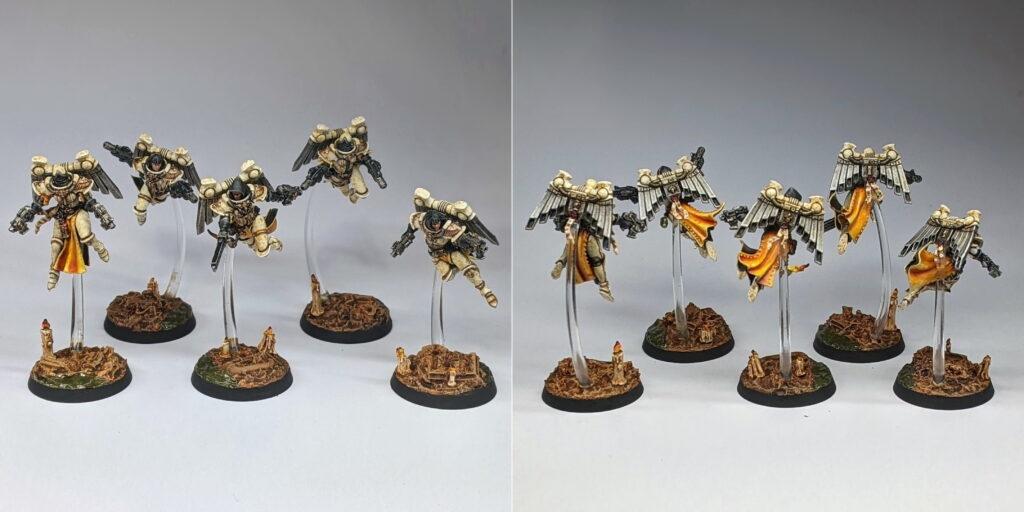
Well, so much for part five being the ‘concluding’ chapter of The Emperor Protects; that’s another two squads and three characters done for the Order of the Dying Light. At least the runway is now completely clear for the new releases accompanying the 9th Edition Codex later this year.
So what’s next on the painting table? Well, as I alluded to earlier, I have an Inquisitor that I plan on running alongside my Arco-Flagellants that’s ready to go, but that project has morphed into something else entirely – more on that later. Besides that, I’ve been revamping another, much older project as of late – a minor restoration that has ballooned into a full-blown project in it’s own right. I’m not entirely sure what’s going to appear first on this blog, so keep your eyes peeled for more updates soon.
Until then, thanks for reading, and happy wargaming!
1 Aside from a sizeable pile of Sororitas infantry, my backlog at this moment mostly consists of all of the Blackstone Fortress expansions, a couple of Neverborn crews and some Bayou bits and pieces for Malifaux, a trio of metal Ents, a few Isenguard characters, 6x Iron Hills Crossbowmen, 10x MKV Assault Marines and a Blood Bowl Human Booster. Pretty much all ‘nice to have’ units and expansions that I know I’m going to want some day. I don’t feel too bad about it.
2 I find that this is a mainly an issue when you are not actively playing that game or faction at that time. Need is a great motivator, and it’s a lot easier to return to an old project if you think it’s going to help improve your gaming experience. In those cases, it can actually be quite useful to have miniatures on your backlog to satisfy the urge to work on them immediately.
4 There’s just something about having at least one unit from each slot in the Force Organisational Chart that really appeals to me. It makes the army seem more well rounded and complete, I suppose.
